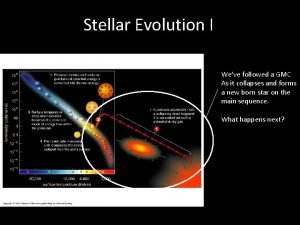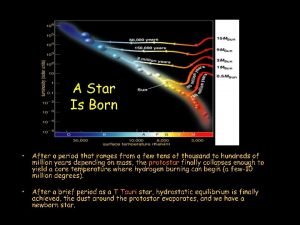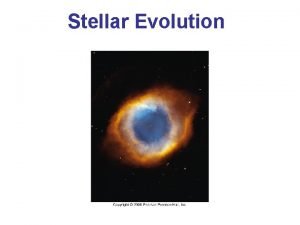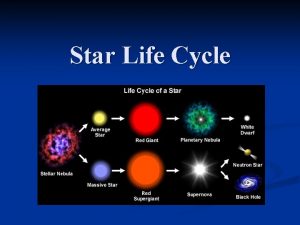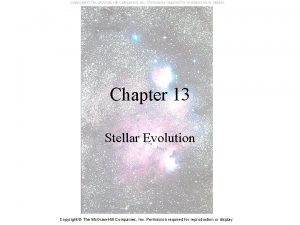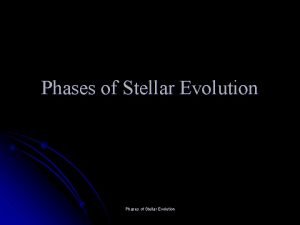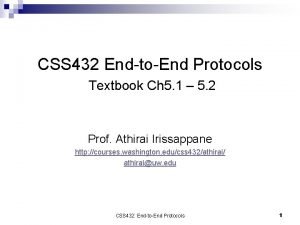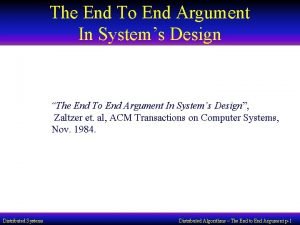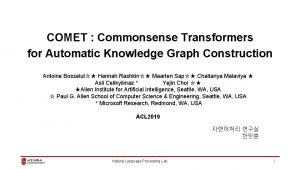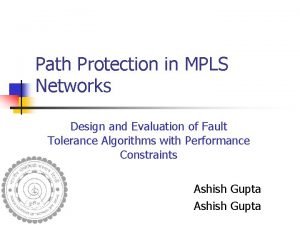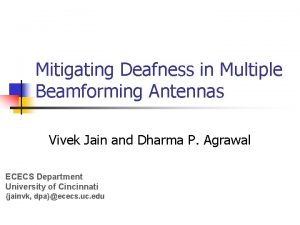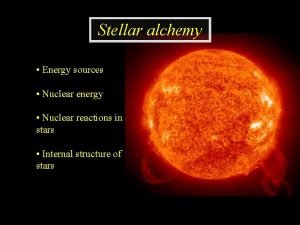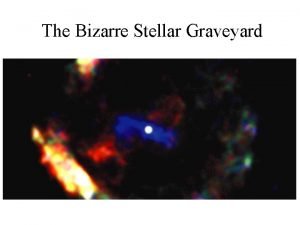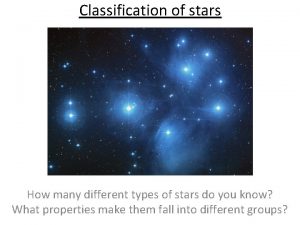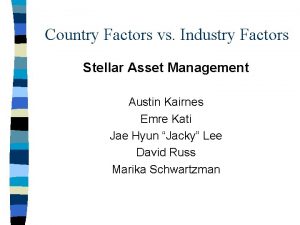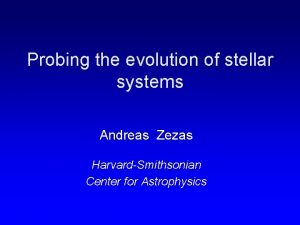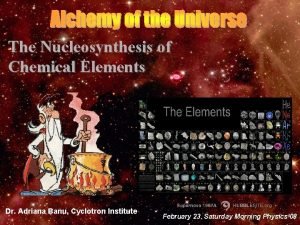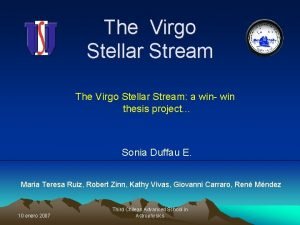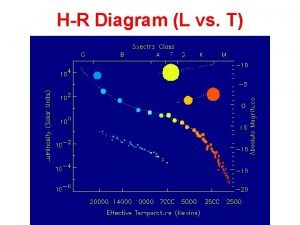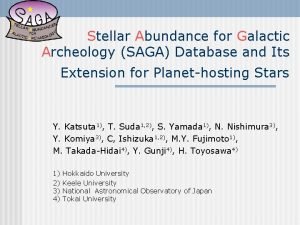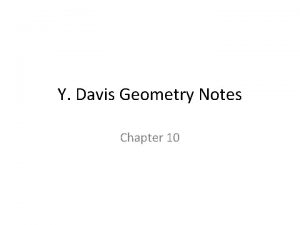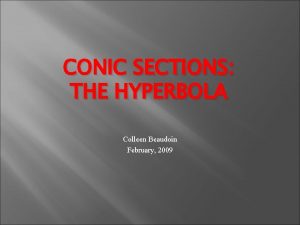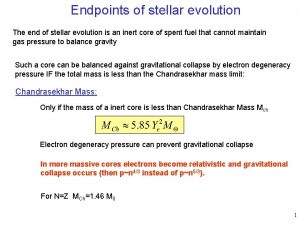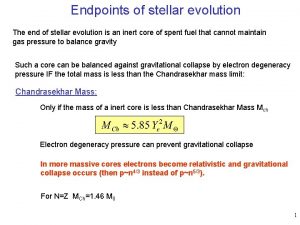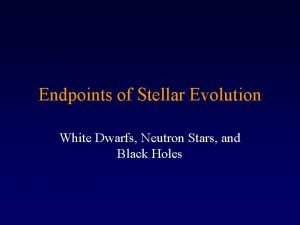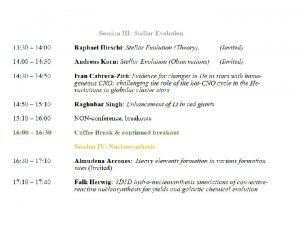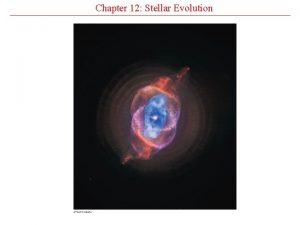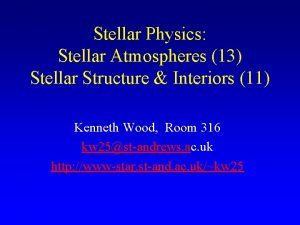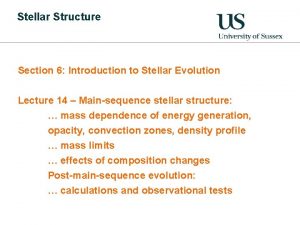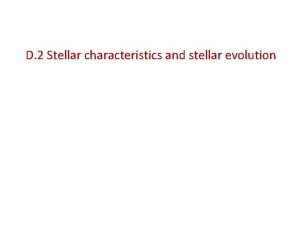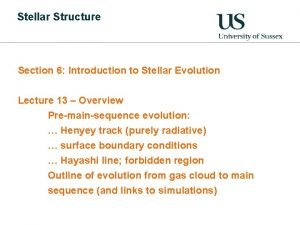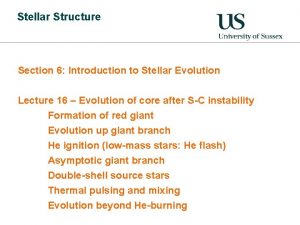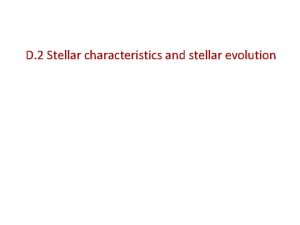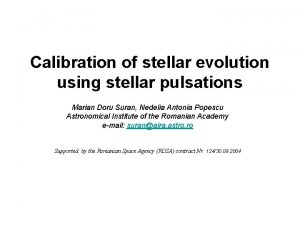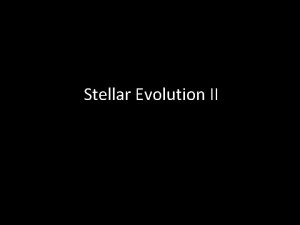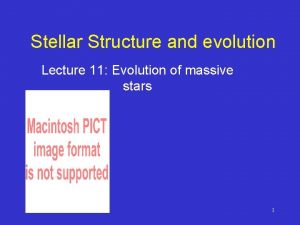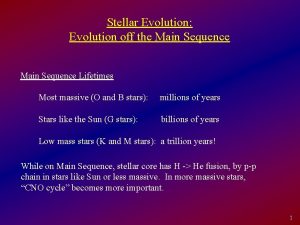Endpoints of stellar evolution The end of stellar








































- Slides: 40

Endpoints of stellar evolution The end of stellar evolution is an inert core of spent fuel that cannot maintain gas pressure to balance gravity Such a core can be balanced against gravitational collapse by electron degeneracy pressure IF the total mass is less than the Chandrasekhar mass limit: Chandrasekhar Mass: Only if the mass of a inert core is less than Chandrasekhar Mass Mch Electron degeneracy pressure can prevent gravitational collapse In more massive cores electrons become relativistic and gravitational collapse occurs (then p~n 4/3 instead of p~n 5/3). For N=Z MCh=1. 46 M 0 1

Mass and composition of the core depends on the ZAMS mass and the previous burning stages: MZAMS Last stage Core < 0. 3 M 0 H burning He 0. 3 - 8 M 0 He burning C, O 8 -12 M 0 C burning O, Ne, Mg > 8 -12 M 0 Si burning Fe Mass Result M<MCh core survives M>MCh collapse How can 8 -12 M 0 mass star get below Chandrasekhar limit ? 2

Death of a low mass star: a “Planetary Nebula” Envelope of star blown into space And here’s the core ! a “white dwarf” image: HST Little Ghost Nebula distance 2 -5 k. Ly blue: OIII green: HII red: NII 3

Why “white dwarf” ? • core shrinks until degeneracy pressure sets in and halts collapse star is HOT (gravitational energy !) star is small WD M-R relation Hamada-Salpeter Ap. J. 134 (1961) 683 4

nearby stars: Perryman et al. A&A 304 (1995) 69 HIPPARCOS distance measurements Where are the white dwarfs ? there (small but hot white (B~V)) 5

Pagel, Fig. 5. 14 6

Supernovae If a stellar core grows beyond its Chandrasekhar mass limit, it will collapse. Typically this will result in a Supernova explosion at least the outer part of a star is blown off into space But why would a collapsing core explode ? a) CO or ONe. Mg cores that accrete matter from a companion star can get beyond the Chandrasekhar limit: Further collapse heats star and CO or ONe. Mg burning ignites explosively Whole star explodes – no remnant b) collapsing Fe core in massive star Fe cannot ignite, but collapse halted by degenerate NUCLEON gas at a radius of ~10 km 7

core collapse supernova mechanism 1. pre SN star 2. Fe core proto neutron star infalling outer core inner core outgoing shock from rebounce 3. proto neutron star 4. infalling outer core proto neutron star matter flow gets reversed - explosion stalled shock neutrinos revived shock neutrino heated layer 8

Some facts about Supernovae: 1. Luminosity: Supernovae might be the brightest objects in the universe, and can outshine a whole galaxy (for a few weeks) Energy of the visible explosion: ~1051 ergs Luminosity : ~10 9 -10 L 0 2. Frequency: ~ 1 -10 per century and galaxy 9

Tarantula Nebula in LMC (constellation Dorado, southern hemisphere) size: ~2000 ly (1 ly ~ 6 trillion miles), disctance: ~180000 ly 10

Tarantula Nebula in LMC (constellation Dorado, southern hemisphere) size: ~2000 ly (1 ly ~ 6 trillion miles), disctance: ~180000 ly 11

Supernova 1987 A seen by Chandra X-ray observatory, 2000 Shock wave hits inner ring of material and creates intense X-ray radiation 12

13

HST picture Crab nebula SN July 1054 AD Dist: 6500 ly Diam: 10 ly, pic size: 3 ly Expansion: 3 mill. Mph (1700 km/s) Optical wavelengths Orange: H Red : N Pink : S Green : O Pulsar: 30 pulses/s 14

Cas A supernova remnant … seen over 17 years youngest supernova in our galaxy – possible explosion 1680 (new star found in Flamsteeds catalogue) 15

3. Observational classes (types): Type I no hydrogen lines depending on other spectral features there are sub types Ia, Ib, Ic, . . . Type II hydrogen lines Why are there different types ? Answer: progenitor stars are different Type II: collapse of Fe core in a normal massive star (H envelope) Type I: 2 possibilities: Ia: white dwarf accreted matter from companion Ib, c collapse of Fe core in star that blew its H (or He) envelope into space prior to the explosion 16

Plateau ! Origin of plateau: earlier: later: H-envelope outer part: transparent (H) inner part: opaque (H+) photosphere As star expands, photosphere moves inward along the T=5000 K contour (H-recombination) T, R stay therefore roughly fixed = Luminosity constant (as long as photosphere wanders through H-envelope) 17

There is another effect that extends SN light curves: Radioactive decay ! (Frank Timmes) Radioactive isotopes are produced during the explosion there is explosive nucleosynthesis ! 18

44 Ti 59. 2+-0. 6 yr 3. 93 h 1157 g-ray 19

Distance 10, 000 ly 20

Measure the half-life of 44 Ti It’s not so easy: Status as of 1997: 21

Method 1: Prepare sample of 44 Ti and measure activity as a function of time number of sample nuclei N: activity = decays per second: Measure A with g-ray detector as a function of time A(t) to determine N 0 and l 22

ANL: Ahmad et al. PRL 80 (1998) 2550 23

Berkeley: T 1/2=59. 2 yr Norman et al. PRC 57 (1998) 2010 24

National Superconducting Cyclotron Facility at Michigan State University Cyclotron 2 Cyclotron 1 Ion Source Fragment Separator Make 44 Ti by fragmentation of 46 Ti beam 1010 46 Ti/s 106/s 44 Ti 25

Fast beam feature 1: production of broad range of beams Example: Fragmentation Technique (for different beam) Beam 86 Kr Color: 1 e-4 to >1000/s Might sound low, but …. 26

Method 2: Measure A AND N 0 at a one time Standard Setup: 44 Ti Use this setup from time to time: energy loss d. E 44 Ti Cyclotron Pulse Time of flight Si detector Plastic det. 27

Fast beam feature 2: high selectivity – step 1: Separator Recall in B-field: r=mv/q. B Recall: d. E/dx ~ Z 2 28

Fast beam feature 2: high selectivity – step 2: Particle ID Energy loss d. E (Si-PIN diode or ionization chamber) Br selection by geometry/slits and fields TOF Stop (fast scintillator) measure m/q: Br = mv/q (relativistic Br=gmv/q !) m/q = Br/v v=d/TOF Start (fast scintillator) Measure Z: d. E ~ Z 2 29

determine number of implanted 44 Ti 60. 3 +- 1. 3 years Goerres et al. Phys. Rev. Lett. 80 (1998) 2554 30

Explosive Nucleosynthesis Shock wave rips through star and compresses and heats all mass regions composition before and after core coll. supernova: Explosive C-Si burning • similar final products • BUT weak interactions unimportant for >= Si burning (but key in core !!!) • BUT somewhat higher temperatures • BUT Ne, C incomplete (lots of unburned material) Explosive Si burning: Deepest layer: full NSE 28 Si 56 Ni Further out: a-rich freezeout • density low, time short 3 a cannot keep up and a drop out of NSE (but a lot are made from 2 p+2 n !) • result: after freezeout lots of a ! mass cut somewhere not ejected • fuse slower – once one 12 C is made quickly captures more result: lots of a-nuclei (44 Ti !!!) 31

The “mass zones” in “reality”: 1170 s after explosion, 2. 2 Mio km width, after Kifonidis et al. Ap. J. Lett. 531 (2000) 123 L 32

Contribution of Massive Stars to Galactic Nucleosynthesis Displayed is the overproduction factor X/Xsolar This is the fraction of matter in the Galaxy that had to be processed through the scenario (massive stars here) to account for todays observed solar abundances. To explain the origin of the elements one needs to have • constant overproduction (then the pattern is solar) • sufficiently high overproduction to explain total amount of elements observed today “Problem” zone these nuclei are not produced in sufficient quantities low mass stars Type Ia supernovae Novae calculation with grid of massive stars 11 -40 M 0 (from Woosley et al. Rev. Mod. Phys. 74 (2002)1015) 33

Type Ia supernovae white dwarf accreted matter and grows beyond the Chandrasekhar limit star explodes – no remnant 34

Nucleosynthesis contribution from type Ia supernovae CO or ONe. Mg core ignites and burns to a large extent into NSE Iron/Nickel Group (Pagel 5. 27) 35

Mass loss and remnants 36

Supernova remants – neutron stars Neutron star kicked out with ~600 mi/s SN remnant Puppis A (Rosat) 37

An isolated neutron star seen with HST: 38

Neutron star properties Mass: Radius: ~10 km ! 39

40
 Stellar evolution
Stellar evolution Stellar evolution flow chart
Stellar evolution flow chart Stellar evolution
Stellar evolution Stellar evolution
Stellar evolution Stellar evolution diagram
Stellar evolution diagram Stellar evolution
Stellar evolution Zero age main sequence
Zero age main sequence Yichao zhou
Yichao zhou End to end
End to end Compiler front end and back end
Compiler front end and back end End to end argument
End to end argument End-to-end construction of nlp knowledge graph
End-to-end construction of nlp knowledge graph Compiler front end vs back end
Compiler front end vs back end End to end delay
End to end delay End to end accounting life cycle tasks
End to end accounting life cycle tasks End-diastolic volume vs end-systolic volume
End-diastolic volume vs end-systolic volume End-to-end procurement life cycle
End-to-end procurement life cycle Zirkularstapler
Zirkularstapler End to end delay
End to end delay Preload stroke volume
Preload stroke volume Stellar alchemy
Stellar alchemy Masses in the stellar graveyard
Masses in the stellar graveyard What is stellar parallax?
What is stellar parallax? Stellar asset management
Stellar asset management Mizar luminosity
Mizar luminosity Iptv hosting
Iptv hosting Stellar
Stellar Adriana banu
Adriana banu Stellar motion matlab
Stellar motion matlab Stellar assessment
Stellar assessment Stellar wifi
Stellar wifi Virgo stellar
Virgo stellar Stellar formation
Stellar formation Stellar saga
Stellar saga Atmospheric heaven
Atmospheric heaven How to find the missing endpoint formula
How to find the missing endpoint formula Endpoints of conjugate axis
Endpoints of conjugate axis The shortest arc connecting two endpoints on a circle
The shortest arc connecting two endpoints on a circle Magbigay ng tatlong fraction na katumbas ng 26/52
Magbigay ng tatlong fraction na katumbas ng 26/52 Types of i/o devices
Types of i/o devices Facts about hyperbola
Facts about hyperbola
